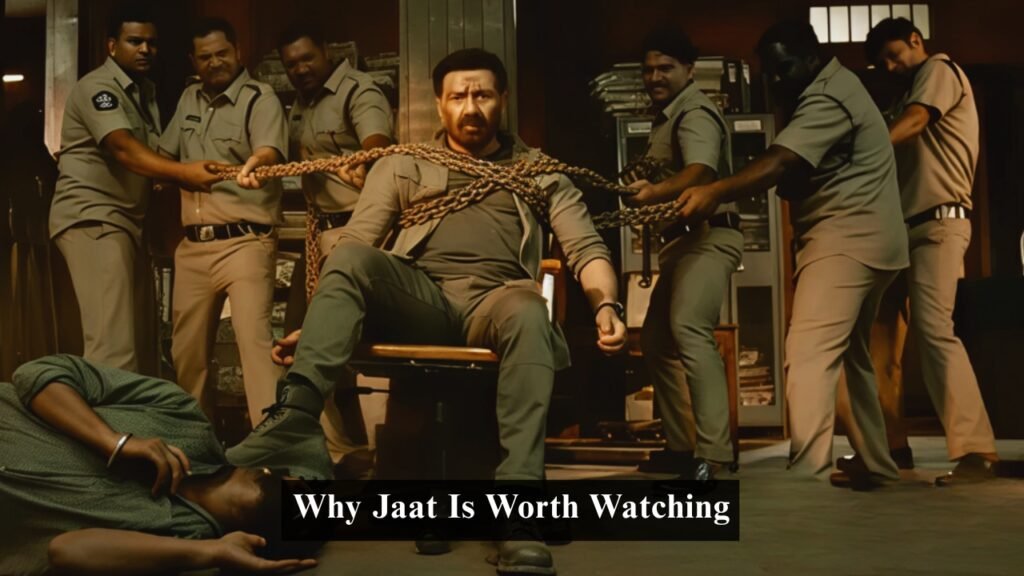A Tale of Pride, Power, and Social Conflict in Rural India
When it comes to Indian cinema that dares to portray the raw and uncomfortable realities of rural life, Jaat stands as a bold and uncompromising effort. In this detailed Jaat movie review, we will take a deep look at the story, character arcs, social messages, direction, performances, and the intricate depiction of caste and power dynamics that form the backbone of the movie.
This film marks the fierce return of Sunny Deol, portraying a character whose sheer pride and uncompromising sense of justice create waves of conflict across a village deeply divided by caste and ambition. It is not just an action movie—it’s a profound exploration of power, politics, and personal pride.
Plot Overview: The Power Struggle That Defines Jaat
In this Jaat movie review, the story unfolds in a remote Indian village, where caste-based hierarchy rules over personal ambition and morality. The central character, Bhola Singh (played by Sunny Deol), returns to his village after years of serving as a soldier. He is determined to bring justice and peace, but instead steps into a web of caste rivalries, political manipulations, and personal vendettas.
The antagonist, Ranatunga (played by Randeep Hooda), is a ruthless figure who uses cunning and brutality to consolidate power over the village. Through a series of confrontations, strategic alliances, and personal betrayals, the movie illustrates how pride and caste can both uplift and destroy individuals.
This Jaat movie review highlights the film’s ability to remain grounded in its setting, portraying every struggle, dialogue, and conflict as deeply tied to real societal dynamics rather than cinematic exaggeration.
Character Arcs: Complex, Real, and Deeply Human
One of the most notable aspects of the Jaat movie review is the emphasis on character development. Bhola Singh is portrayed not as an invincible hero but as a man driven by stubborn pride, honor, and a desire for justice. His internal conflict—the tension between personal ego and the well-being of his village—adds complexity to the narrative.
Ranatunga, as the antagonist, isn’t merely a villain. He is a man shaped by circumstances—poverty, ambition, and betrayal. His rise to power is shown as both terrifying and tragically inevitable, making him a well-rounded character rather than a flat caricature.
Radha, Bhola’s wife, plays a subtle but powerful role, representing the silent yet firm voice of reason in a society that tends to suppress female agency. Her character provides an emotional anchor, helping to balance the film’s aggressive tone.
This Jaat movie review appreciates how every character is layered, making their choices relatable and their downfalls impactful.
Caste Dynamics: The Unspoken Reality
The core theme of Jaat revolves around caste—how it shapes identity, governs power, and perpetuates inequality. The Jaat movie review shows that caste is more than just a label; it is a living, breathing force that influences every action, decision, and conflict in the film.
Through village panchayat meetings, public shaming, and private confrontations, the movie skillfully illustrates how caste is weaponized for personal gain and how it traps generations in cycles of oppression and violence.
What makes Jaat exceptional is its refusal to offer easy answers. It doesn’t present caste as something that can be changed by a single heroic act but shows it as an embedded social structure that requires collective awakening.

Top 5 Most Powerful Scenes in Jaat
Opening Panchayat Dispute – The movie begins with an intense village meeting where caste tensions immediately rise. This scene establishes the political undercurrents and the fragility of peace in the village.
Bhola vs. Ranatunga Confrontation – A raw, unfiltered face-off between the two leads, showing not only physical power but ideological battle—a stand-off that marks the climax of the power struggle.
Radha’s Silent Rebellion – A moment where Bhola’s wife subtly challenges his decisions, reflecting the larger theme of women’s suppressed voice in rural power structures.
Election Manipulation Sequence – The film reveals how politicians exploit caste rivalries for electoral gains, with characters caught between personal morals and societal expectations.
Final Tragic Confrontation – The movie’s final act where Bhola’s pride leads to irreversible consequences, symbolizing how rigid adherence to caste and ego leads to downfall.
This Jaat movie review underscores that these scenes aren’t included merely for drama but carry a heavy emotional and political weight that lingers.
Direction & Cinematography: Realism Above All
Director Gopichand Malineni employs a grounded approach throughout the film. The cinematography is subtle, focusing on earthy tones and long, unbroken shots that mirror the slow, oppressive pace of rural life.
This Jaat movie review notes the choice to avoid flashy visuals or over-the-top action sequences. Instead, the film thrives on atmosphere—dust-filled roads, cramped village houses, and raw facial expressions—helping the audience feel like a part of the setting.
The pacing, though slow, is deliberate. Every scene is meant to build tension, allowing the viewer to reflect on the characters’ moral ambiguity rather than get lost in action.
Performance: Actors Deliver Deep, Nuanced Roles
Sunny Deol’s performance is a major highlight in this Jaat movie review. His portrayal of Bhola Singh shows a man who is rough around the edges yet filled with moral conviction. The actor doesn’t rely on exaggerated heroism but lets subtle expressions speak for the internal turmoil.
Randeep Hooda’s Ranatunga is equally compelling. His performance walks a fine line between fearsome and tragic, making the audience question whether he is entirely villainous or a victim of his circumstances.
Supporting actors, especially Saiyami Kher and Regina Cassandra, contribute depth without stealing focus. Their performances reflect the silent suffering of women in a male-dominated rural world.
Social Message: No Sugar-Coating, Only Realism
The Jaat movie review emphasizes that the film doesn’t attempt to be a moral sermon. Instead, it presents a mirror to society. The harsh reality of caste discrimination, political greed, and individual pride is shown as it is—raw and unembellished.
Rather than resolving these issues with a neat ending, the film leaves the audience pondering. Is redemption possible when the system itself is corrupt? Is personal pride worth the destruction of family and community?
This is where Jaat succeeds. It challenges the viewer rather than entertains them, prompting reflection on the societal structures we accept.
Music and Sound Design: Subtle Yet Impactful
The music in Jaat, composed by Thaman S, plays a quiet role. Unlike typical Bollywood musicals, the soundtrack doesn’t interrupt the story but supports its mood.
Ambient sounds—the distant cry of cattle, political slogans, village drums—create an immersive experience. In this Jaat movie review, the sound design stands out for its restraint, allowing silence to speak louder than any musical score.
Audience and Critical Reception
At release, Jaat received mixed responses. Many applauded its bold take on caste and rural power dynamics, while some found the pacing slow and the subject too heavy.
The Jaat movie review observes that this polarizing reception is exactly what the film aims for. It’s not meant to please but to provoke thought.
The movie’s box office success indicates that audiences are ready to confront difficult narratives, provided they are told with honesty and depth.
Why Jaat Is Worth Watching
This Jaat movie review recommends the film for those seeking more than just entertainment. The movie’s strength lies in its unflinching gaze at a society bound by caste, greed, and pride.
If you appreciate character-driven stories where every choice matters, and where every silence screams louder than dialogues, Jaat is a must-watch.
Final Verdict: A Powerful, Thought-Provoking Experience
In this comprehensive Jaat movie review, we conclude that Jaat doesn’t offer easy answers. It’s a mirror held up to the dark underbelly of rural India, showing how pride and caste shape—and often ruin—human lives.
This film is not about heroes and villains but about people trapped in a system they cannot escape. Its strength lies in authenticity, performances, and the painful beauty of its tragedy.




